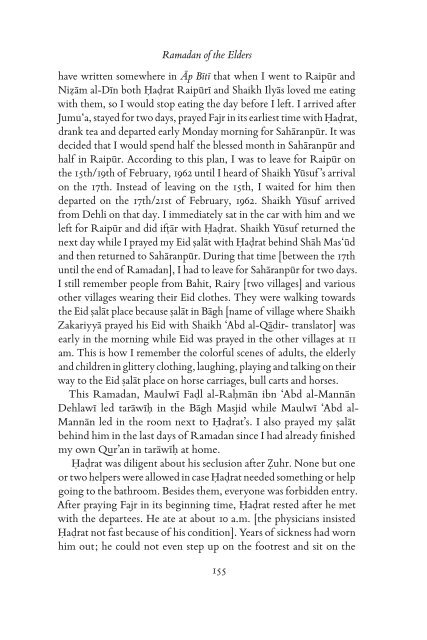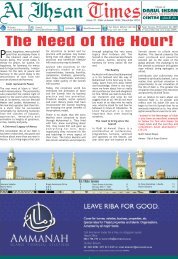TheRamadan of Shaykh Al-Hadith Ml ZakariyyaKandelwi by Dr Muhammad Ismail Memon Madani
TheRamadan of Shaykh Al-Hadith Ml ZakariyyaKandelwi by Dr Muhammad Ismail Memon Madani
TheRamadan of Shaykh Al-Hadith Ml ZakariyyaKandelwi by Dr Muhammad Ismail Memon Madani
Create successful ePaper yourself
Turn your PDF publications into a flip-book with our unique Google optimized e-Paper software.
Ramadan <strong>of</strong> the Elders<br />
have written somewhere in Āp Bītī that when I went to Raipūr and<br />
Niżām al-Dīn both Ĥađrat Raipūrī and Shaikh Ilyās loved me eating<br />
with them, so I would stop eating the day before I left. I arrived after<br />
Jumu‘a, stayed for two days, prayed Fajr in its earliest time with Ĥađrat,<br />
drank tea and departed early Monday morning for Sahāranpūr. It was<br />
decided that I would spend half the blessed month in Sahāranpūr and<br />
half in Raipūr. According to this plan, I was to leave for Raipūr on<br />
the 15th/19th <strong>of</strong> February, 1962 until I heard <strong>of</strong> Shaikh Yūsuf ’s arrival<br />
on the 17th. Instead <strong>of</strong> leaving on the 15th, I waited for him then<br />
departed on the 17th/21st <strong>of</strong> February, 1962. Shaikh Yūsuf arrived<br />
from Dehli on that day. I immediately sat in the car with him and we<br />
left for Raipūr and did ifţār with Ĥađrat. Shaikh Yūsuf returned the<br />
next day while I prayed my Eid śalāt with Ĥađrat behind Shāh Mas‘ūd<br />
and then returned to Sahāranpūr. During that time [between the 17th<br />
until the end <strong>of</strong> Ramadan], I had to leave for Sahāranpūr for two days.<br />
I still remember people from Bahit, Rairy [two villages] and various<br />
other villages wearing their Eid clothes. They were walking towards<br />
the Eid śalāt place because śalāt in Bāgh [name <strong>of</strong> village where Shaikh<br />
Zakariyyā prayed his Eid with Shaikh ‘Abd al-Qādir- translator] was<br />
early in the morning while Eid was prayed in the other villages at 11<br />
am. This is how I remember the colorful scenes <strong>of</strong> adults, the elderly<br />
and children in glittery clothing, laughing, playing and talking on their<br />
way to the Eid śalāt place on horse carriages, bull carts and horses.<br />
This Ramadan, Maulwī Fađl al-Raĥmān ibn ‘Abd al-Mannān<br />
Dehlawī led tarāwīĥ in the Bāgh Masjid while Maulwī ‘Abd al-<br />
Mannān led in the room next to Ĥađrat’s. I also prayed my śalāt<br />
behind him in the last days <strong>of</strong> Ramadan since I had already finished<br />
my own Qur’an in tarāwīĥ at home.<br />
Ĥađrat was diligent about his seclusion after Ẓuhr. None but one<br />
or two helpers were allowed in case Ĥađrat needed something or help<br />
going to the bathroom. Besides them, everyone was forbidden entry.<br />
After praying Fajr in its beginning time, Ĥađrat rested after he met<br />
with the departees. He ate at about 10 a.m. [the physicians insisted<br />
Ĥađrat not fast because <strong>of</strong> his condition]. Years <strong>of</strong> sickness had worn<br />
him out; he could not even step up on the footrest and sit on the<br />
155



